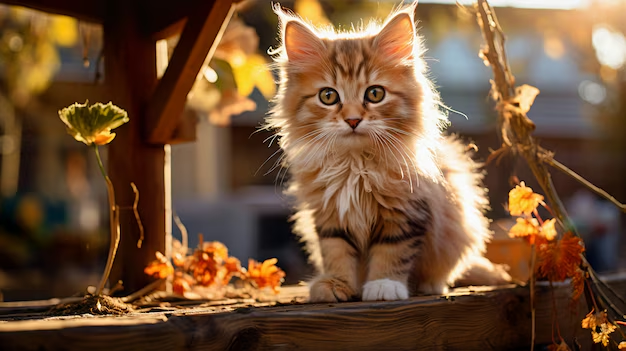Exploring the Lore Behind Famous Warrior Cat Names

The Warrior Cats series, created by Erin Hunter, is a collection of novels that has captured the imaginations of readers with its world of wild cats living in Clans, each with their unique traditions, cultures, and names. The naming of Warrior Cats is more than just a way to identify individual characters; it is deeply tied to the lore and traditions of the Clans. These names often reflect a cat’s personality, appearance, or role within the Clan, making them significant not only in storytelling but also in representing the values and beliefs of the Warrior Cat universe. If you’re inspired by this lore and want to create your own Warrior Cat characters, check out this fantasy cat name generator to explore a wide range of unique and fitting names!
In this article, we’ll explore the lore behind some of the most famous Warrior Cat names, uncovering their meanings and how they relate to the characters’ journeys. We’ll also delve into the traditions that guide the naming process in the series and how these names evolve as the cats grow and change.
1. The Significance of Warrior Cat Names
Warrior Cat names are crafted using a specific naming convention. Typically, a cat’s name has two parts: a prefix and a suffix. The prefix often describes an aspect of the cat’s appearance, birth circumstances, or personality, while the suffix indicates the cat’s rank or an attribute of their skills or character. For example:
- Kits are given names with the suffix “kit” (e.g., Firekit).
- Apprentices have the suffix “paw” (e.g., Firepaw).
- Warriors are granted a new suffix upon earning their warrior name (e.g., Fireheart).
- Leaders receive the suffix “star” in honor of their rank (e.g., Firestar).
These naming conventions are not just a way to signify a character’s rank but also represent the cats’ connection to their Clan’s culture and their individual growth throughout the series. The name changes reflect the cats’ journeys and achievements, making each name an integral part of the character’s identity.
2. Famous Warrior Cat Names and Their Lore
Let’s dive into some of the most iconic Warrior Cat names, exploring their origins and significance.
2.1. Firestar: The Heroic Leader
Firestar, originally known as Rusty, is one of the most famous characters in the Warrior Cats series. His journey from a kittypet (house cat) named Rusty to the leader of ThunderClan is a central storyline. His name changes as he grows and earns his place among the Clan cats:
- Rusty:
His original name as a kittypet, which hints at his domestic origins. - Firepaw:
When Rusty joins ThunderClan, he receives the apprentice name Firepaw. The prefix “Fire” is symbolic of his bright ginger pelt and foreshadows his fiery spirit and destiny to bring change to the Clans. - Fireheart:
As a warrior, his name is changed to Fireheart, reflecting his bravery, loyalty, and the compassion that defines his character. - Firestar:
Upon becoming the leader of ThunderClan, he is given the name Firestar, with the “star” suffix representing his leadership and spiritual connection to StarClan, the warrior ancestors.
Firestar’s name evolution represents his journey from a house cat to a legendary leader, highlighting the importance of resilience, bravery, and loyalty in the Warrior Code.
2.2. Bluestar: The Wise and Tragic Leader
Bluestar, the leader of ThunderClan when Rusty first joins, is another iconic character whose name carries deep meaning. Her original names and their lore are as follows:
- Bluekit:
As a kit, she is named for her gray-blue fur, which is uncommon and striking among Clan cats. - Bluepaw: Her apprentice name retains the “Blue” prefix, signifying her distinctive appearance and hinting at the significant role she would later play.
- Bluefur:
Her warrior name symbolizes her noble and cool-headed nature, as well as the sorrow she carries from personal losses. - Bluestar:
When she becomes the Clan leader, she is named Bluestar, with the “star” signifying her leadership. Her name also reflects her wisdom and the burden she bears, particularly her grief over giving up her kits to become leader.
Bluestar’s story is one of sacrifice, leadership, and tragedy. Her name serves as a reminder of the heavy responsibilities that come with power and the personal costs leaders often endure.
2.3. Tigerstar: The Ambitious Villain
Tigerstar is one of the most infamous villains in the Warrior Cats series. His name and its changes reflect his character’s dark ambitions:
- Tigerkit:
His name starts with the “Tiger” prefix due to his dark tabby stripes, resembling a tiger’s coat. This name foreshadows his aggressive nature. - Tigerpaw:
As an apprentice, his name retains the “Tiger” prefix, indicating that his fierceness and ambition were evident from a young age. - Tigerclaw:
After becoming a warrior, he earns the suffix “claw,” symbolizing his prowess in battle. This name reflects not just his strength but also hints at his ruthless nature. - Tigerstar:
When he becomes a leader (though controversially), his name changes to Tigerstar. The “star” is meant to symbolize leadership, but in his case, it also serves as an ironic twist, as his ambitions lead to tyranny rather than noble leadership.
Tigerstar’s character arc serves as a cautionary tale about the dangers of unchecked ambition and the consequences of pursuing power at all costs.
2.4. Cinderpelt: The Healer with a Warrior’s Heart
Cinderpelt’s story is one of resilience and adapting to unexpected circumstances. Her name changes tell a tale of overcoming hardship:
- Cinderkit:
Named for her dark gray fur, she starts her life with the hopes of becoming a great warrior. - Cinderpaw:
As an apprentice, she is eager and full of energy, but an accident crushes her dreams of becoming a warrior when she is severely injured. - Cinderpelt:
After accepting her fate, she becomes a medicine cat apprentice and earns the name Cinderpelt. The “pelt” suffix reflects her new role as a healer, and her courage to embrace a different path than she initially envisioned.
Cinderpelt’s journey shows the importance of adaptability and finding strength in one’s true calling, even when life does not go as planned.
3. Naming Traditions Across the Clans
The naming conventions vary slightly between the different Clans, but some traditions are shared across all:
- ThunderClan:
Names are often tied to the cat’s appearance, skills, or the natural world. The focus is on traits that represent strength, bravery, or nature. - RiverClan:
Names may be associated with water-related elements, such as “Stream,” “Ripple,” or “Mist,” reflecting their affinity for swimming and fishing. - WindClan:
Names might evoke the open moorlands and the wind, with prefixes like “Breeze,” “Swift,” or “Hare” being common. - ShadowClan:
Names here often have darker connotations, reflecting the Clan’s mysterious nature. Prefixes such as “Night,” “Dark,” or “Crow” are frequently used. - StarClan:
When a leader dies, they join StarClan, where they keep the “star” suffix, symbolizing their eternal connection to the warrior ancestors.
The naming traditions provide insight into each Clan’s culture and values, as names often reflect the natural environment in which the Clan lives or qualities they admire.
4. The Evolution of a Warrior Cat’s Name
A Warrior Cat’s name changes as they age and advance in rank:
- Kits begin with the “kit” suffix, highlighting their youth and inexperience.
- Apprentices move to the “paw” suffix, symbolizing their training period and journey toward adulthood.
- Warriors receive a suffix that usually reflects their skills or personality traits, such as “heart” for bravery, “claw” for fighting prowess, or “fur” for their coat.
- Leaders adopt the “star” suffix as a mark of their new role and spiritual status.
Each name change is a rite of passage that represents the cat’s growth and the Clan’s recognition of their achievements.
5. How Names Impact a Character’s Destiny
The names given to Warrior Cats can be prophetic, reflecting the roles they are destined to play. This element of foreshadowing is a recurring theme in the series. For example:
- Firestar’s name, with its fiery imagery, foreshadows his role as a bringer of change and renewal to the Clans.
- Tigerstar’s name hints at his ferocious and dangerous nature, as well as the destructive path he would take.
- Bluestar’s name evokes a sense of calm and sadness, foreshadowing her tragic story and the weight she carries as a leader.
In this way, names do more than just identify a cat; they are woven into the fabric of the story and help set the tone for each character’s journey.
Conclusion
The lore behind Warrior Cat names is rich and thoughtfully crafted, making the characters feel more connected to their world. Each name serves as a reflection of a cat’s appearance, personality, or journey, while also representing the traditions and culture of the Clans. The naming conventions add depth to the series, as characters grow into their names or find new meanings in them over time. From Firestar’s heroic rise to Cinderpelt’s acceptance of her new path, the evolution of these names tells a story within a story, adding layers of meaning to the characters’ lives.
FAQs
1. What is the significance of the suffixes in Warrior Cat names?
In Warrior Cats, suffixes provide insight into a cat’s age, rank, and personality. Kits have the suffix “kit,” apprentices have “paw,” warriors typically have names that reflect their traits (like “heart” for bravery or “claw” for fighting skill), and leaders receive the suffix “star” to signify their elevated status and connection to StarClan. This naming system helps illustrate the growth and development of each character throughout the series.
2. Can Warrior Cats’ names change, and if so, how?
Yes, Warrior Cats’ names can change as they progress through their lives. A cat typically starts with a “kit” suffix during their youth, transitions to “paw” as an apprentice, and then receives a unique warrior name upon completing their training. If a cat becomes a leader, their name changes again to include the “star” suffix. These changes reflect their personal growth, achievements, and the responsibilities they take on within their Clan.
3. What do the names of Warrior Cats reveal about their personalities?
The names of Warrior Cats often reflect their personalities, skills, and roles within their Clans. For example, a cat named “Fireheart” embodies bravery and loyalty, while a cat named “Tigerstar” suggests ambition and a fierce nature. The prefixes are carefully chosen to foreshadow the character’s journey, creating a deeper connection between their name and their actions throughout the story. Names in the Warrior Cats series often serve as a narrative device, hinting at the cats’ destinies and defining traits.



